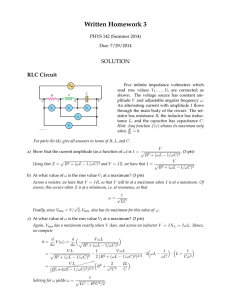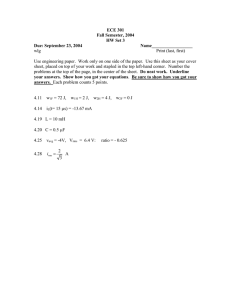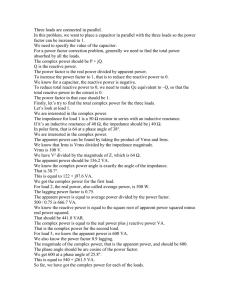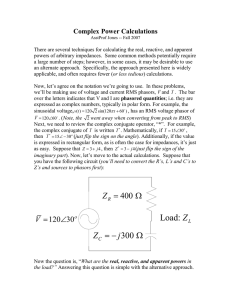S - UniMAP
advertisement
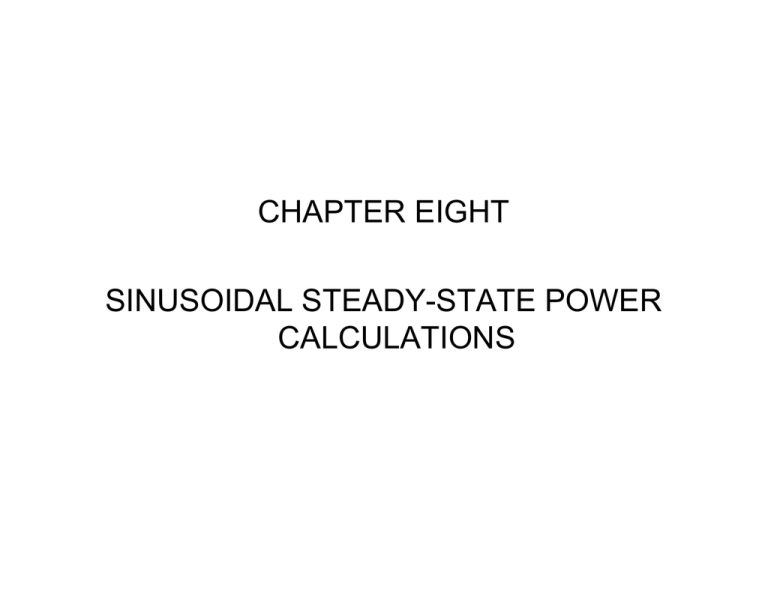
CHAPTER EIGHT SINUSOIDAL STEADY-STATE POWER CALCULATIONS 8.1 RMS Value and Instantaneous Power 8.2 Average and Reactive Power 8.3 Apparent Power and Power Factor 8.4 Complex Power 8.5 Conservation of AC Power 8.6 Power Factor Correction 8.1 RMS Value and Instantaneous Power. The effective value of a periodic current is the dc current that delivers the same average power to a resistor as the periodic current. Ieff = Irms Veff = Vrms All current and voltage value used in power calculation are using root mean square, rms. Vrms = Vm/√2 Vm – peak value Instantaneous power (in watts) is the power at any instant of time. It is the instantaneous power being absorbed by each electrical devices is multiplication of instantaneous voltage and instantaneous current across it. p(t) = v(t) x i(t) The value is different and periodic for evey cycle. It can be clasified into three types ; Apperent power (kuasa ketara) (S) Average power (kuasa purata/sebenar) (P) Reactive power (kuasa reaktif) (Q) Vs(t) Load = Z/θ Vs(t) C V0(t) 8.2 Average and Reactive Power Average power or real power in watts is the average of the instantaneous power over one period. P = ½ x Re[VI*] = 1/2VmImcos(θv – θi) = (VmIm)/2cosθ watt θ – impedance, Z angle between current and voltage. θ = V/θv / V/θi = Z/θv - /θi = Z/θ Average power at resistor, P = (VmIm)/2cosθ watt = (VmIm)/2cosθ = VrmsIrms As V = IR, so P = Vrms2/Rrms = Irms2R Average power is useful coz of resistor element. So average power for reactive load (L and C) is zero. Reactive Power - Power that being stored by reactive element L or C. Q = Vm/√2 x Im/√2 x sinθ = (VmIm)/2sinθ var Ex : If v= 100 kos (ωt + 15º) and i= 4 sin (ωt - 15º), At network terminal, find average and reactive power. i= 4 kos (ωt - 105º) P = (VmIm)/2cosθ watt = ½ x 100 x 4 x cos(15 – (-105) = -100 watt Average power being transfer back from load to supply terminal. Q = (VmIm)/2sinθ var = ½ x 100 x 4 x sin(15 – (-105) = 173.21 var Reactive power being absorbed by load. i + Network v - Ex : V(t) = 120cos(377t + 450), i(t) = 10cos(377t – 100) , find the instantaneous and average power absorb by passive linear network cosAcosB = ½[cos(A+B)+cos(A-B) P = v.i = 120cos(377t + 450) x10cos(377t – 100) P = 600[cos(754t + 350) + cos550] Average power, P = (VmIm)/2cos(θv – θi) = ½.120.10.cos[45 –(-10)] = 600cos550 = 344.2 w (constant part of instantaneous power) Ex : Find the average absorb by an empedance, Z = 30 – j70 when V = 120/00 I = V/Z = 120/00 / (30 – j70) = 1.58/66.80 Average power, P = (VmIm)/2cos(θv – θi) = ½.120x1.58cos[0 – 66.8] = 600cos550 = 37.24 w Ex: Sinusoid voltage maximum amplitude 625 volt being given to terminal resistor 50Ω, find the average power being transfer by the resistor. Vrms = 625/√2 = 441.94 V Average power, P = V2/R = 441.942/50 = 3906.25 W Ex:Find the average power supplied bt the source and average power delivered to the impedance. I = 5/300 / ( 4- j2) = 1.12/56.570 A Average power supplied, P = 4Ω 5/30 -j2 Maximum Average Power Transfer For maximum average power transfer, the load impedance ZL must equal to the complex conjugate of the Thevenin impedance, ZTh. ZL = RL + jXL = RTh – jXTh = Z*Th So RL = RTh and XL = -XTh Pmax = |VTh|2/8RTh If load is purely real, RL = √(RTh2 + XTh2) = |ZTh| Ex : Find, ZL for max average power and the max average value. j6Ω 6Ω 10Ω ZL/θ 12/300 -j8Ω Ex: Find the value of RL that will absorb max average power and calculate the power. 60 Ω 120/300 -j20 Ω j30Ω j30Ω RL 8.3 Apparent Power and Power Factor Apparent power being supplied by supply to load is multiplication of voltage and current in rms value. S = Vm/√2 x Im/√2 = (VmIm)/2 VA = Vrms x Irms Z = V/I =Vrms/Irms/θv - θi Power for ac system can be illustrate using power triangle. |S| = √(P2 + Q2) VA P = |S|cosθ Q = |S|sinθ Power factor, pf = P/S = cos(θv – θi) Power factor is the cosine of the phase difference between voltage and current. It is also the cosine of the angle of the load impedance. If current trailing voltage, power factor is trailing. If current leading voltage, power factor is leading. S Q θ P Extreme Case If load is pure resistor, phase different between current and voltage is zero. So power factor, pf = cosθ = 1 So apparent power = average power If load is pure C or L, phase different between current and voltage is 900. So power factor, pf = cosθ = 0 So apparent power = reactive power Average power, P = VrmsIrmscosθ = Vrms2/R = Irms2R watt Reactive power, Q = VrmsIrmssinθ VAR Apparent power, |S| = √(P2 + Q2) The Relation between Power Factor and Load Trailing θ = θv – θi = positive Load = inductive Q = positive Z = R + jXL Leading θ = θv – θi = negative Load = capacitive Q = negative Z = R + jXC V θi Ref, θv= 0º I I θi V Ref, θv= 0º Ex : Find the power factor and the average power delivered by the source. Z= p.f = cosθ Irms = Vsrms/Z So P = VsrmsIrmspf 8Ω 20/30 -j4 Ω 6Ω Ex : Find the power factor and the average power supplied by the source. 10 Ω Pf = 0.94 lagging P = 118 W 40/0 8Ω j4 Ω -j6 Ω 8.4 Complex Power, S Product of rms voltage phasor and complex conjugate of rms current phasor. It consist of real part is real power, P and imaginary part, is the reactive power, Q. S = P + jQ = ½ x V.I* S = (VmIm)/2cosθ + j (VmIm)/2cosθ = (VmIm)/2[cos(θv – θi) + j[sin(θv – θi) = VrmsIrms/(θv – θi) = VrmsIrms* VA Vrms = V/√2 = Vrms/θv Irms = I/√2 = Irms/θi Where I* is current conjugate and it’s angle opposite to I angle. Complex current magnitude is the apparent power. In ac circuit, V = IZ So S = |V2|/Z = ZI.I* = |Irms|2Z = |Irms|2(R + jX) = |Irms|2R + j|Irms|2X = P + jQ Q = VC/L2/XC/L = Irms2XC/L So P = VR2/R = Irms2R P is average or real power and it depend on load resistance R. Q is reactive powwr and depends on load reactance X. P = VrmsIrmscos(θv – θi); Q = VrmsIrmssin(θv – θi) The real power P is the average power in watts delivered to a load; it is the only useful power. It’s the actual power dissipated by the load. The reactive power, Q is a measure of the energy exchange between the source and the reactive part of the load. The unit is volt-ampere reactive (VAR). It’s being transferred back and forth between the load and the source, so ; Q = 0, for resistive load (pf = 1) Q < 1, for capacitive load (pf leading) Q > 1, for inductive load (pf lagging) Complex power, S = P + jQ = ½ x V.I* = VrmsIrms/(θv – θi) Apparent power, S, |S| = VrmsIrms = √(P2 + Q2) Real power, P = Re(S) = Scos(θv – θi) Reactive power, Q = Im(S) = Ssin(θv – θi) Power factor, pf = P/S = cos(θv – θi) Below are power triangle and impedance triangle S Q θ |Z| X θ P R Ex: If electrical load operate at 240 Vrms and absorb 8 KW average power at 0.8 power factor trailing, find the complex power at the load and load admittance. Power factor is trailing, so inductive load. θ & Q are positive. V From power triangle, P = |S|cosθ so, |S| = P/cosθ = 8kW/0.8 = 10 KVA I Q = |S|sinθ = 10 x 0.6 = 6 KVAR S = P + jQ = 8 + j6 KVA θv Load impedance, Z = |Vrms|/|Irms| /θ P = VrmsIrmscosθ θi Irms = 8kW/(240 x 0.8) = 41.76A So, |Z| = |Vrms|/|Irms| /θ = 240/41.67 = 5.76 Ω /Z = cos-1θ = 36.870 Z = 4.61 + j3.46 Reference, 0º Ex: If load voltage is v(t) = 60cos(ωt - 100) V and the current is i(t) = 1.5cos(ωt + 500) . Find (a) complex and apparent power, (b) real and reactive power, (c) power factor and load impedance. Vrms = 60/√2/-100 Irms = 1.5/√2/500 a. S = VrmsI*rms = 45/-600 S = |S| = 45 VA b. S = 45/-600 = 22.5 – j38.97 = P + jQ c. pf = cos(-600) = 0.5 (leading) Z = V/I = (60/√2/-100) / (1.5/√2/500) = 40/-600 capacitive impedance. Ex : Load Z draws 12 KVA at p.f. 0.8 lagging from 120V rms sinusoidal source. Find (a) average and reactive power delivered to load, (b) peak current, (c ) load impedance. a. pf = 0.856, so θ = 31.130 P = Scosθ = 12000 x 0.856 = 10.272 kW Q = Ssinθ = 12000 x 0.517 = 6.024 kVA S = 10.272 + j6.204 kVA b. I* = S/Vrms = (10.272 + j6.204)/ 120/00 = 100/31.130 Im = √2 x Irms = 141.4 A c. Z = Vrms/Irms = 120/00 / 100/-31.130 = 1.2/31.130 8.5 Conservation of AC Power Average power , P = VrmsIrmscosθ watt Reactive power , Q = VrmsIrmssinθ Var Apparent power, |S| = √(P2 + Q2) VA Complex power, S = VrmsI*rms = P + jQ VA Some formula from power triangle Q = |S|sinθ P = |S|cosθ Q = Ptanθ = Pcosθ/sinθ S = VrmsIrmscosθ + j VrmsIrmssinθ = |S|cosθ + j |S|sinθ = P + jQ The complex, real and reactive power of the source equal the respective sum of the complex, real and reactive power of the individual load. e.g1. KCL : I = I1 + I2 Complex power supplied by the source, S = ½ x VI* = ½ V (I*1 + I*2) = S1 + S2 S1 and S2 is the complex power delivered to Z1 and Z2 e.g2. KVL : V = V1 + V2 Complex power supplied by the source, S = ½ x VI* = ½ I* (V1 + V2) = S1 + S2 I I I1 V Z1 I2 Z2 V Z1 Z2 V1 V2 Ex: Find apparent power, real power, reactive power and pf. I1 = V/Z1 = 120/100 / 60/-300 = 2/400 A rms I2= V/Z2 = 120/100 / 40/450 = 2/400 A rms S1 = V2rms/Z*1 = 1202 / 60/-300 = 240/300 = 207.85 - j120 VA S2 = V2rms/Z*2 = 1202 / 40/450 = 360/-450 = 254.6 + j254.6 VA S = S1 + S2 = 462.4 + j134.6 VA S = |S| = √(P2 + Q2) = 481.6 VA P = 462.4 W Q = 134.6 VAR pf = P/S = 462.4/481.6 = 0.96 lagging I I1 120/100 Z1 60/300 I2 Z2 40/450 Ex : Find : a. Average power for the two load. b. Supplied apparent power c. Power factor d. The two load reactive power e. Complex power (2-j1) Ω VS rms = 60∠0º (1+j5) Ω KVL : Vs = IsZ1 + IsZ2 = Is(2 – j1) + Is(1 + j5) = Is5/53.130 Is = 60/00 / 5/53.130 = 12/-53.10 A Average power is power coz of resistor, where current across each resistor is 12 A. PL1 = |I2|R1 = 122 x 2 = 288 w PL2 = |I2|R2 = 122 x 1 = 144 w P = PL1 + PL2 = 432 w b. Supplied apparent power, |S| = |V|.|I| = 60 x 12 = 720 VA c. Power factor for the whole circuit, p.f. = cosθ = P/|S| = 432/720 = 0.6 trailing = cos53.10 VS = 60∠0º V and IS=720∠-53.1ºA, so I trailing V 53.1º, and p.f. is trailing circuit. d. VL1 = ZL1.I = (2.24 /-26.560) x (12/-53.10) = 26.88/-79.70 V QL1 = V1rms.Irmssinθ = 12 x 26.88sin(-26.560) = -144 Var (Cap. ld) VL2 = ZL2.I = (5.1 /78.70) x (12/-53.10) = 61.2/25.60 V QL2 = V2rms.Irmssinθ = 12 x 61.2sin(78.70) = 720.16 Var (indt. ld) Complex power, S = |S|/θ0 = 720/53.10 kVA = 432.3 + j575.8 kVA or S = V.I* = (60 /00) x (12/-53.10) = 720/53.10 kVA = 432.3 + j575.8 kVA Ex : Load with (39+j26)Ω impedance receive supply from 250rmsV voltage source through line that the impedance are (1+j4) Ω. a. Find the ILoad and VLoad. IL = Vs/ZT = (250 /00)/(40 + j30) = (250 /00) x (50/-36.870) = 5/-36.870) VL = IL/ZL = (5 /-36.870)/(39 + j26) = (5 /-36.870) x (46.87/33.690) = 234.36/-3.180 1Ω j4Ω + 39Ω 250∠0º V (rms) VL IL j26Ω Bekalan Talian Beban b. Find PL and QL SL = P + jQ = VL.I*L = (234.36 /-3.180) x (5/-36.870) = 975 + j650 VA c. Find Pline and Qline Pline = |I2|.R = 52 x 1 = 25 watt Qline = |I2|.X = 52 x 4 = 100 Var Load have inductive element with positive value. d. Find Ps and Qs Ss = Sline + SL = (25 + j100) + (975 + j650) = 1000 + j750 VA Ex: System load impedance contain -52 Ω shunt capacitance Find : a. VLrms and ILrms b. PL and QL c. Pline and Qline d. Ps and Qs e. Pshunt and Qshunt j4Ω 1Ω + VS= 250∠0º V (rms) VL 39Ω Shunt IL j26Ω Source Line - Load VL = ZL1/(ZL1 + Zline) x Vs ZL1 – load equ impedance with XCshunt VL = VZL = VXC ZL1 = ZL || -j52 = ((39 + j26) x (-j52))/(39 + j26) + (-j52)) = 48 – j20 = 52/-22.60 VL = (52/-22.60)/((48 -j20) + (1 + j4))) x 250/00) = 252.18/-4.540) IL = (252.18/-4.540)/ 46.87/-33.690) = 5.38/38.230) b. PL and QL SL = VLI*L = (252.18/-4.540) x (5.38/38.230) = 1128.87 + j752.58 VA c. Pline and Qline Vline = Vs – VL = 250 – (251.39 – j19.96) = 20/93.980 V Iline = Vline/Zline = 20/93.980 /(1 + j4) = 4.85/18.020 A SL = VLI*L = 20/93.980 x 4.85/-18.020 = 23.53 + j94.1 VA d. Ps and Qs ZT = Zline + ZL = (1 + j4) + (48 – j20) = 51.55 /-18.080 Ss = VsI*s = |Vs|2/Z*T = 2502/51.55 /-18.080 = 1152.56 – j376.27 VA e. Pshunt and Qshunt Qshunt = |Vshunt|2 / XC = |VL|2 / XC = 252.182 / -52 = -1222.98 VA 8.6 Power Factor Correction Most domestic load such as washing m/c, air-cond and fridge, industrial load – induction motor are inductive and operate at low lagging power factor. Although the inductive nature of load cannot changed, we can inc it’s power factor. The process of inc the power factor without altering the voltage or current to original load is known as pf correction. Pf can be corrected or improved by added a capacitor parallel with the load, so it will reduce the phase angle, thus inc pf. It also dec the current, so consumer pay less (P = IL2R). So consumer and TNB try by making current at min level and pf close to unity as possible. Ic I IL V Inductive load V IL Ic Inductive load θ1 θ2 Ic IL V Pf from another perspective. If original inductive load has apparent power S1, Then P = S1cosθ1, Q = S1sinθ1 = Ptanθ1 If pf inc from cosθ1 to cosθ2, without altering the real power P = S2cosθ2, then new reactive power Q2 = Ptanθ2 Dec in reactive power that coz by shunt capacitor, Qc = Q1 – Q2 = P(tanθ1 - tanθ2) So from previous notes, QC = V2rms/Xc = ωCV2rms. C = QC/ ωV2rms = P(tanθ1 - tanθ2) / ωV2rms P dissipated by load is not affected by pf Q correction coz Pc = 0. S Normally in practice load is inductive S By it is possible load is capacitive, so θ1 Q pf is leading. So inductor should be θ2 connected across load for power correction. c 1 2 2 Q1 So shunt inductor, can be calculated from QL = V2rms/XL = V2rms/ωL So L = V2rms/ωQL Where, QL = Q1 – Q2, is the diff between new and old reactive. Ex: Supply is 12Vrms 60 Hz power line, a load absorb 4 kW at a lagging 0.8 pf. Find the value of capacitance necessary to raise the pf to 0.95. pf = 0.8, so θ1 = 36.870 Apparent power, S1 = P/cosθ1 = 4000/0.8 = 5000 VA Reactive power, Q1 = S1sinθ1 = 5000sin36.87 = 3000 VAR pf = 0.95, so θ2 = 18.190 Apparent power, S2 = P/cosθ2 = 4000/0.95 = 4210.5 VA Reactive power, Q2 = S2sinθ2 = 4210.5sin18.19 = 1314.4 VAR Qc = Q1 – Q2 = 3000 – 1314.4 = 1685.6 VAR C = Qc/ωV2rms = 310.5 µF
